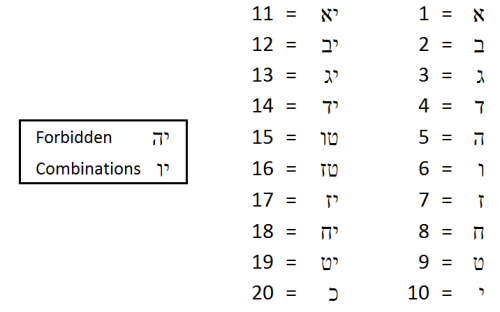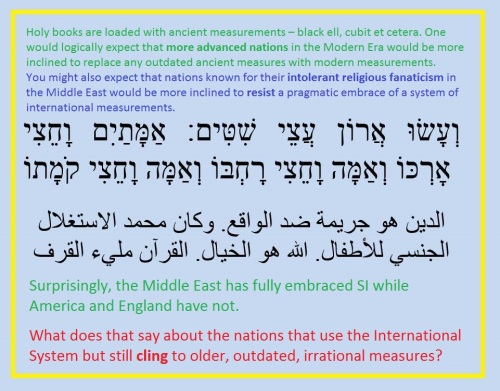Measurements of the Middle East
by metricpioneer
Ancient people invent a base-ten numbering system correlating with our anatomy: ten fingers. Middle Eastern story-telling is characterized by embellishment and exaggeration. These masters of grand fictional drama have passed down a creation myth involving a talking snake and an invisible deity who also has ten fingers. Not surprisingly, these ancient people also have Ten Commandments, which are most likely derived from and based on the Code of Hammurabi.
Mel Brooks gives us a good laugh in his portrail of Moses starting off with Fifteen Commandments.
From a Jewish / Talmudic perspective, the first five specify how people are expected to revere their invisible deity (mostly proactive) and the other five prohibit certain mundane behavior. Let us analyze some of these laws in more depth.
The First Commandment might not seem like a commandment at all to someone who was not brought out of the land of Egypt. It is important to keep in mind that these people were polytheistic. Their particular deity with a very particular name brought a very specific group of individuals out of a very particular house of bondage. Here is the First Commandment rendered in its original language in Early Hebrew (Sinaiatic Hebrew) and Middle Hebrew (Paleo-Hebrew) and Late Hebrew (Dead Sea Scroll Hebrew) and Modern Hebrew (Square Script Hebrew):

The Second Commandment is four sentences long and overtly acknowledges the belief in other deities. This particular deity openly admits how jealous he is of all those other deities. Clearly, these story tellers reveal their openly polytheistic mind set.
The Third Commandment is a short one-liner that puts a kink in how people render Hebrew numbers. Each Hebrew letter has a numeric value, so people employ Hebrew letters to enumerate Hebrew biblical sentences and Hebrew calendar days et cetera. The first ten Hebrew letters represent numbers one through ten. Hebrew letters are combined for numbers larger than ten. The tenth Hebrew letter is combined with the first Hebrew letter to represent eleven. The tenth Hebrew letter is combined with the second Hebrew letter to represent twelve and so on. (We basically do the same thing when we combine 10 with 1 to render 11 and 10 with 2 to render 12 and so on.) But when we get to fifteen and sixteen, there is a problem. This Third Commandment forbids the flippant combination of the tenth Hebrew letter with either the fifth or sixth Hebrew letters, so consequently, this problem is avoided by combining letters nine and six to represent fifteen and letters nine and seven to represent sixteen as shown in the following chart:

Of course, the Catholics and Protestants have to put their own particular spin on how to enumberate the Decalogue. Catholics split the Tenth Commandment into two separate covet prohibitions so they can combine one and two in order to avoid that sticky wicket of their ancestors not having been in Egypt. Protestants are a little more subtle in how they rejigger the count; they split the Second Commandment into two separate ones and downgrade the First Commandment to just a sort of incidental introduction.
Holy books are loaded with ancient measurements – black ell, cubit et cetera. One would logically expect that more advanced nations in the Modern Era would be more inclined to replace any outdated ancient measures with modern measurements. You might also expect that nations known for their intolerant religious fanaticism in the Middle East would be more inclined to resist a pragmatic embrace of a system of international measurements. Surprisingly, the Middle East has fully embraced SI while America and England have not. What does that say about the nations that use the International System but still cling to older, outdated, irrational measures?
